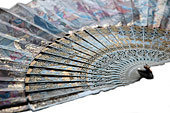Gripping Diversity!
dal 7/11/2011 al 31/3/2012
Segnalato da
7/11/2011
Gripping Diversity!
MAK Austrian Museum of Applied Arts / Contemporary Art, Wien
Fans and Gloves from the MAK Collection. In the exhibition the sartorial and societal significance of fans in Europe is documented and traced via a wide diversity of items from seven centuries, in concert with its presentation of fans will be also shown exquisite examples of European glove design. Curated by Barbara Karl, MAK Curator Textiles and Carpets.

Right up into the 20th century, magnificent fans and gloves were essential
accessories in the wardrobe of the European woman. Fans were viewed as a
symbol of social status while they also served as a medium of nonverbal
communication. And without gloves, the elegant lady of the 19th century was
not properly dressed. Today, the fan leads a niche existence in Europe, while
gloves have lost much of their former decorative qualities. The exhibition
Gripping Diversity! puts these now somewhat neglected accessories firmly in
the spotlight, presenting a selection of 70 items that exemplify fan and glove
design over several centuries.
A great deal of space is devoted to objects from East Asia, where for centuries
fans played a role not only in courtly etiquette but also in everyday culture.
Today, they continue to be used in the performance of traditional dances,
while in Japan, fans continue to be used in everyday life. Alongside painted,
un-mounted fan leaves and fans from China, including a round Chinese
lacquer fan from the 19th century, one particularly outstanding item in this
showing is a Japanese folding screen decorated with recycled fan leaves
taken from dismantled fans.
It was during the early modern period that today’s most common form of fan—
the folding fan—was brought from Asia to Europe by Portuguese merchants
and proceeded to spread from the Iberian Peninsula to reach across the
continent. In the baroque and rococo eras, the fan staged a victorious march
through society. Fan makers designed diverse models ranging from folding
fans to wheel-fans and brisé fans, and their craft became highly respected as
an occupation. As late as the early 20th century, fans made from the most
precious materials and featuring painted decoration were viewed as a
standard component of female dress and served as important instruments of
coquetry. During the 18th century, the so-called language of fans had
developed into a means of nonverbal communication at social events.
The Empire and Biedermeier periods saw fan design become more restrained,
in keeping with the simpler new fashions. While carrying a fan generally
became less and less popular, the fan did experience a final upswing at the
beginning of the 20th century.
In the exhibition, the sartorial and societal significance of fans in Europe is
documented and traced via a wide diversity of items from seven centuries:
these will include an exquisite French cockade fan from the 15th century, an
example of a Venetian flag fan from the 16th century, and a folding fan with
Chinoiserie elements (France or Germany, ca. 1750). One special context in
which fans were used—namely as an important accessory in Christian
religious rites—is illuminated by two exceptionally rare late-medieval cockade
fans; these will be shown together with gloves knitted in gold and intended for
ecclesiastic use.
With the emancipation of women and the attendant transformation of their role
in society following the Second World War, the fan disappeared almost
completely from European fashion. Since then, it has led a shadow-existence
as a souvenir and marketing item, and as an unusual accessory with evening
gowns and at haute couture shows.
In concert with its presentation of fans, the exhibition Gripping Diversity! will
also show exquisite examples of European glove design. Like fans, gloves are
not purely utilitarian objects. Beyond simply protecting their wearers from cold,
dirt and/or injury, gloves also served throughout many centuries of European
history as important instruments of coquetry and as a fashion accessory for
the elegant woman. On display will be valuable examples from various eras,
including contemporary items such as a glove object by Meret Oppenheim;
her object offers a primarily artistic interpretation of this item.
Curator Barbara Karl, MAK Curator Textiles and Carpets
Opening: Tuesday, 8 November, 7 p.m.
MAK
Stubenring 5 - Wien
Opening hours
Tue: 10 a.m.–12 midnight
Wed–Sun 10 a.m.–6 p.m.
Mon closed
Admission
€ 9,90 including MAK Guide
€ 7,90 / reduced € 5,50
Free admission on Saturdays



